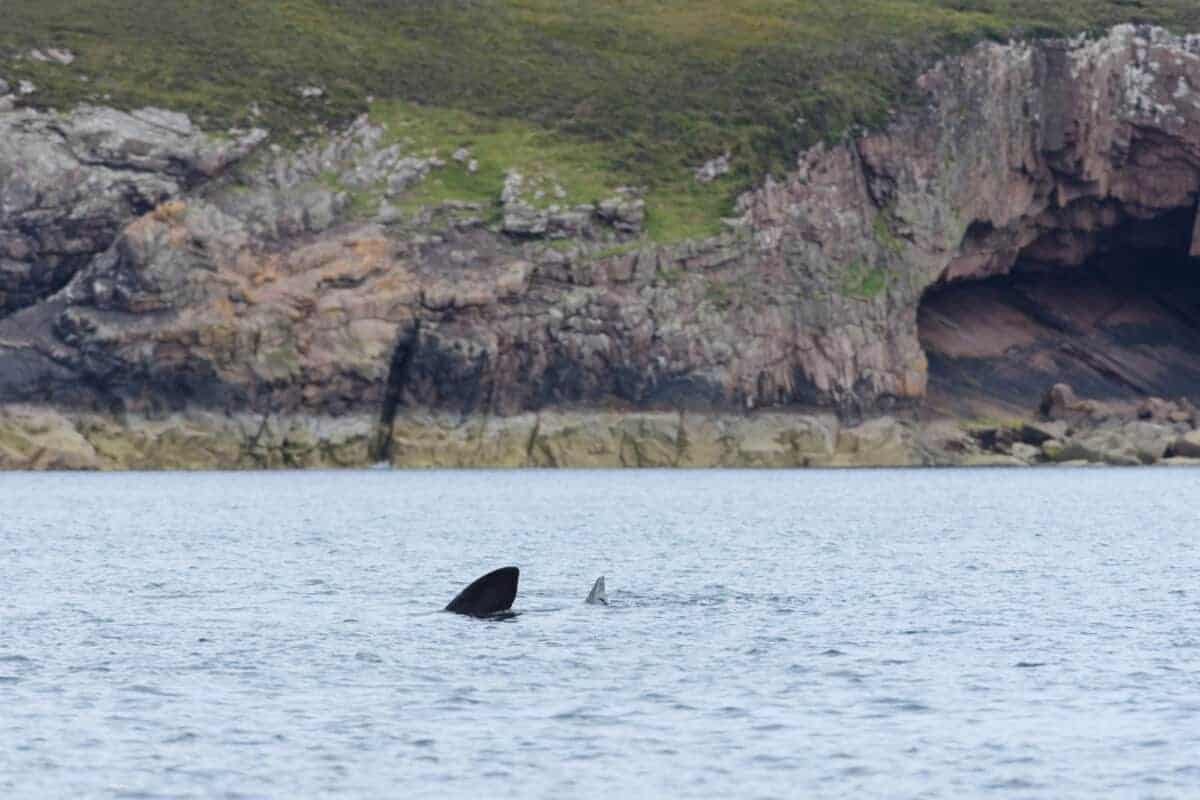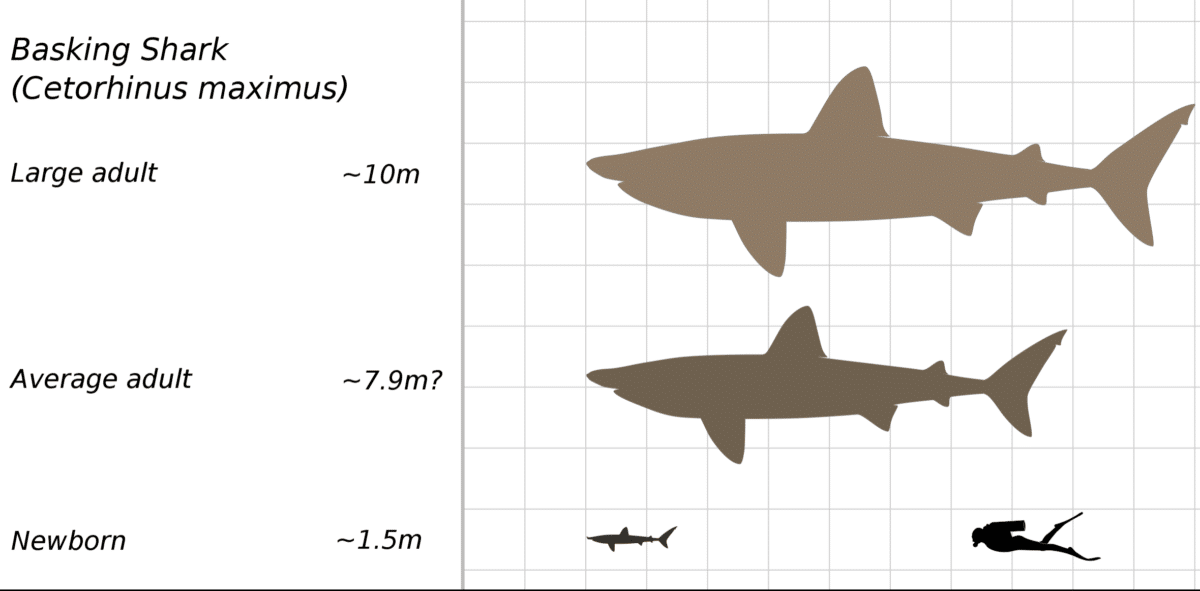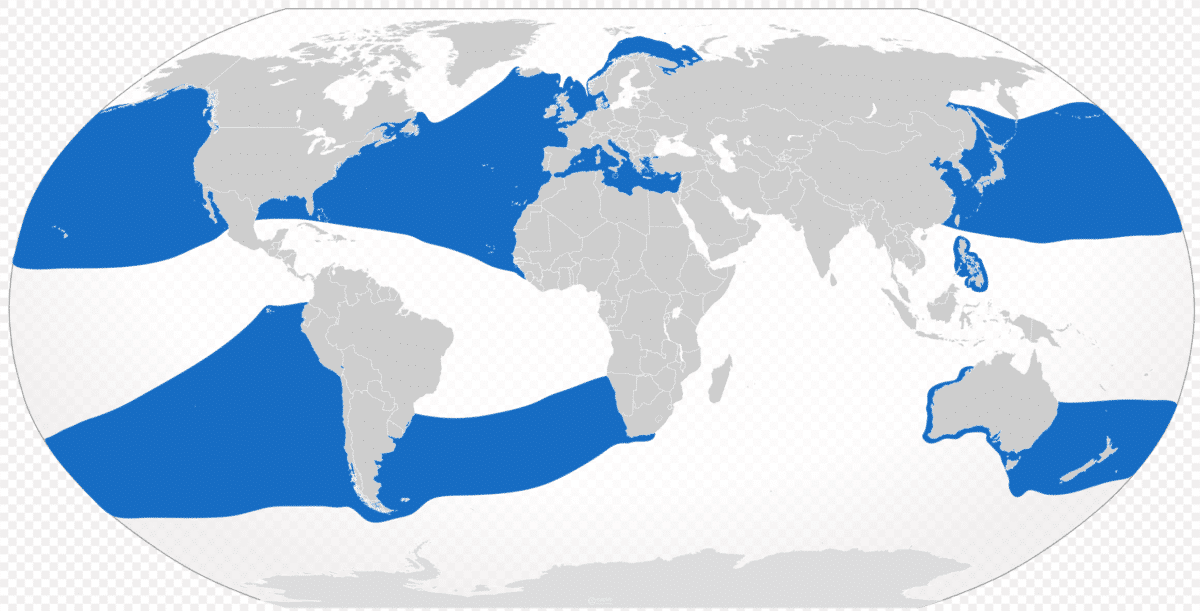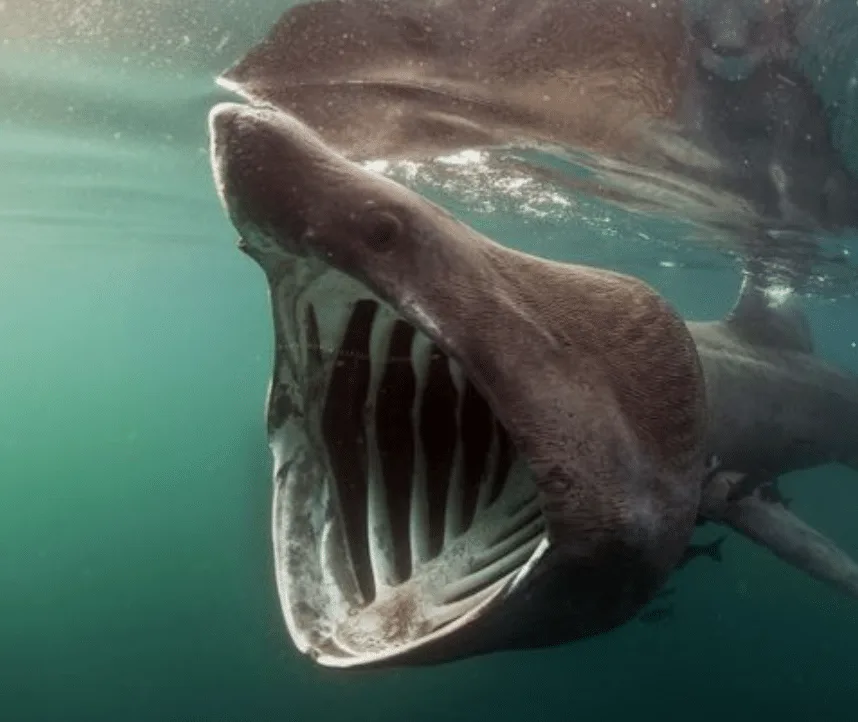Basking sharks, the second-largest fish in our oceans, are fascinating species known for their peculiar feeding habits and gentle nature. These giant, slow-moving creatures prefer the temperate waters of the Atlantic and Pacific Oceans.

Despite their intimidating size, they pose no threat to humans and are filter-feeders, primarily consuming zooplankton. This article will delve into the intriguing world of basking sharks, discussing their characteristics, behavior, and conservation efforts to protect them.
Cruise to any section below!
What Are Basking Sharks?
They are one of the largest fish species in the world and can grow up to 32 feet long and weigh over 5,000 pounds. These sharks have a distinct physical appearance with their massive, elongated bodies and their broad, triangular-shaped dorsal fins. Their skin has a grayish-brown color with a mottled appearance, which helps them blend into their surrounding
Differentiating Features That Set Them Apart From Other Shark Species

Basking sharks are unique among shark species in several ways. For one, they are filter feeders, which means they use their gill rakers to trap small prey, such as plankton and tiny marine organisms. This feeding method is quite different from the hunting and attack tactics that other shark species employ. Additionally, they are passive swimmers and do not have to constantly move to breathe just like other shark species do. This trait allows them to conserve energy and spend more time foraging for their food.
Preferred Habitats And Migration Patterns
Basking sharks are migratory creatures that travel long distances in search of food and suitable breeding grounds. They are found all around the world, primarily in temperate and cold waters. In the summer months, they can be found in coastal areas where plankton blooms occur, usually near shorelines and estuaries. During the winter months, these sharks migrate to deeper waters to conserve their energy and avoid colder surface temperatures.
Global Distribution And Where They Can Be Found

These sharks can be found in all oceans around the world, but they are more commonly found in the Atlantic Ocean. They tend to concentrate in areas with high concentrations of plankton, such as the Irish and North Sea, the Northeast Atlantic, and the Gulf of Maine. They can be found in both shallow and deep waters, at depths of up to 1,000 meters.
Check out: Bengal Tiger Vs. Western Diamondback Rattlesnake.
Surprising Diet Of Basking Sharks: Filter-Feeders Or Active Predators?
Unlike many of their shark counterparts, basking sharks are filter-feeders. They passively swim with their mouths open to filter up to 1,500 metric tons of water per hour. The plankton, small crustaceans, and small fish that get caught in their gill rakers are then funneled into their digestive system. This unique feeding method allows these sharks to consume vast quantities of food in a short amount of time, making them one of the most efficient filter feeders in the marine world.
How They Consume Vast Amounts Of Plankton And Small Marine Organisms
Basking sharks have adaptations that help them consume vast amounts of plankton and small marine organisms. Their large mouths can expand to enormous sizes, allowing them to swallow large volumes of water. Their gill rakers are finely tuned to capture tiny planktonic prey of varying sizes. Additionally, their digestive systems are quite efficient at extracting nutrients from their food, and they have been known to store fat in their livers, which can be used as a long-term energy source. Overall, basking sharks have evolved to be highly effective filter feeders, allowing them to thrive in their ocean habitats.
Behavior And Social Structure
They are solitary creatures, but they occasionally gather in groups at imprinted locations. Imprinting is the process where sharks learn to associate specific environments with particular activities, such as feeding or mating. These areas are known as aggregation sites and can attract significant numbers of sharks.
Basking sharks are classified as passive-feeding animals. Their mouths are lined with many tiny, sharp teeth which are not used for tearing or shredding prey, but instead, filter phytoplankton and small krill from the seawater. Basking sharks have a slow, steady swimming pattern, and they often glide close to the surface with their dorsal fin and tail exposed. This action, known as “basking,” is what gave the sharks their name.
Reproduction And Life Cycle
They exhibit ovoviviparity, wherein the female carries eggs internally, and the offspring emerge fully developed. The gestation period lasts 2-3 years, making it one of the longest among sharks. Females give birth to litters of 6-25 pups, which measure around 4-5 feet long at birth and weigh approximately 28 pounds.
Basking shark males mature at 12 years old and the females mature at 16, with an average lifespan of 50 years. The basking shark’s slow growth rate and low reproductive success rate indicate it’s vulnerable to population decline.
Conservation Status
Throughout the 20th century, humans extensively hunted basking sharks for their liver oil, meat, and fins, resulting in a marked population decline. The Convention on the International Trade in Endangered Species (CITES) took action in 2002 by adding them to the list of protected species. Despite stringent protections, the basking sharks’ food and breeding habitats remain under threat due to climate change, pollution, and fishing activities.
Basking Sharks And Humans
Despite their imposing size, basking sharks pose no threat to humans, establishing their reputation as gentle giants of the sea. They do not have a taste for human flesh and are more interested in filter-feeding on plankton instead. Nevertheless, they have been recorded inadvertently colliding with boats or fishing gear, resulting in potential harm to both the sharks and the humans in such encounters. In certain regions, laws actively safeguard basking sharks by prohibiting their hunting or capture. It is important for humans to respect these laws and to be mindful of the impact they have on the ocean ecosystem, including the basking shark.
Research And Scientific Discoveries
In recent years, research on basking sharks has increased, leading to many scientific discoveries. For example, researchers have used tagging technology to track the movements of basking sharks and learn more about their migration patterns. By studying the genetics of these sharks, scientists have also been able to identify different populations of basking sharks, which can help with conservation efforts. Additionally, scientists have studied the biology of the basking shark to learn how they are able to filter feed efficiently, which could have implications for water filtration technology.
Basking Sharks: Gentle Giants Of The Ocean
Many view basking sharks as the ocean’s gentle giants. Despite their large size, they are docile and pose little threat to humans or other marine animals. Their unique filter-feeding mechanism allows them to consume large amounts of plankton without harming other organisms. Basking sharks are also unique in their appearance, with their elongated snouts and large gill slits. These features make them fascinating animals to observe and study.
Future Outlook
The future of basking sharks remains uncertain, as their population numbers continue to decline in many areas. It is important for humans to take steps to protect these animals, such as implementing conservation measures and reducing the impact of fishing gear on their population. Additionally, ongoing research and scientific discoveries can help us understand more about the biology and behavior of basking sharks, which can aid in conservation efforts. By working together and taking a proactive approach, we can help ensure the survival of these gentle giants of the ocean for generations to come.
Frequently Asked Questions
A basking shark is the second-largest living shark, after the whale shark, and can typically be found in the temperate waters of the Atlantic and Pacific Oceans.
Basking sharks are filter-feeders, which means they consume vast amounts of zooplankton, small fish, and invertebrates by swimming with their mouths open and filtering water through specialized gill rakers.
Yes, basking sharks are considered a vulnerable species by the International Union for Conservation of Nature (IUCN). Various conservation efforts, including protective legislation and fishing regulations, have been implemented to protect them.
Key Points
| Basking sharks are the second-largest fish in the world, growing up to 32 feet long and weighing over 5,000 pounds. They are filter-feeders, consuming zooplankton and small marine organisms. |
| Basking sharks have a unique appearance: elongated bodies, triangular-shaped dorsal fins, and grayish-brown mottled skin. They have five pairs of gill slits used for filter feeding. |
| These sharks are passive swimmers, conserving energy as they move. They prefer temperate waters and migrate to coastal areas in summer for plankton blooms and deeper waters in winter. |
| Basking sharks were heavily hunted in the 20th century, leading to a decline in their population. They are now classified as vulnerable, with conservation efforts in place to protect them. |
| Despite their large size, basking sharks are harmless to humans. Research and scientific discoveries have helped understand their migration patterns and feeding mechanisms, aiding in conservation efforts. |
Closing Thoughts
This species is one of the ocean’s most magnificent creatures and continues to intrigue scientists and marine enthusiasts with its unique feeding habits and gentle demeanor. Despite their imposing size, these creatures play a vital role in maintaining marine biodiversity. However, their vulnerable status highlights the need for continued conservation efforts. As we further our understanding of these remarkable creatures, it’s crucial that we also advocate for their protection and preservation, ensuring that future generations can also marvel at the wonder of basking sharks.
Thanks for reading along! If you enjoyed this article, check out our related article links below for more.
Next up:
- Whale Sharks
- Tiger Shark Encounters
- The Great White Shark: Apex Predator of the Ocean
- Gorilla And Anaconda In Focus
- The English Bulldog
- Largest Asian Elephant
- The Largest Gorilla Ever Recorded
Join our Forum for free today!

- Huge Pet Bison Breaks Into House - July 22, 2024
- Giant Black Bear Surprises Beachgoers by Emerging from the Ocean in Florida - July 22, 2024
- Brave Man Plays Instrument While Huge Bear Caresses His Shoulder - July 22, 2024



